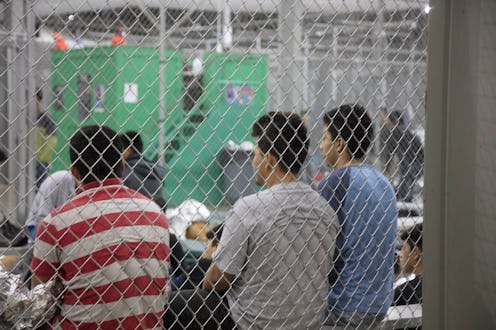News
This Update On Migrant Families Separated At The Border Doesn't Exactly Clear Things Up

On Friday, U.S. Customs and Border Protection (CBP) announced that it unified "approximately 500 children" with their parents after they were separated at the border, according to CNN. It sounds like great news, right? Except the status of thousands more children remains murky at best, according to multiple news outlets.
In a statement to CNN on Friday, a CBP official said the agency "expects that all unaccompanied children in their custody who were separated from adults who were being prosecuted will have been reunited with their families."
On Friday, The Associated Press reported that an administration official said approximately 500 children were reunited with their families. Those children reunited were reportedly part of the more than 2,300 kids who had been separated at the border since the zero-tolerance policy went into effect in May. CNN, however, did not state if the 500 reunited families came from those 2,300 kids separated from their parents.
Because of CBP's role as a passthrough agency for apprehended immigrants to go to other governmental agencies for longer-term solutions, CNN reported that it's likely the kids in question were separated from their parents "within the last 72 hours." This is because "unaccompanied alien children" are required to be transferred from Department of Homeland Security (DHS) custody to that of the Department of Health and Human Services (HHS) within 72 hours, according to DHS.
The Associated Press also reported that the federal public defender's office that represents people from El Paso to San Antonio indicated on Thursday that there would be a roll back of the zero-tolerance policy. The Department of Justice denied this turn of events, according to The Associated Press.
The numbers for how many families need to be reunited and what that reunification process would look like remain murky. On Friday, CNN published a letter from CBP to congressional offices. The email from CBP congressional affairs staffer Pete Ladowicz said those 500 reunified families were more than 15 percent of total separated families. This means the number of separated families could be more than 3,000.
"The administration continues to work to reunify prosecuted parents with their children," Ladowicz in an email obtained by CNN. "U.S. Customs and Border Protection has unified approximately 500 children (over 15%) with their parents who had been referred for prosecution for illegal entry. US Immigration and Customs Enforcement and Health and Human Services are developing a process to be centered at ICE's Port Isabel Detention Center to continue unification efforts."
Follow-up questions from the network went unanswered.
On Tuesday, Vox reported that administration officials said 2,342 children were separated from 2,206 parents between May 5 and June 9 at the southern border.
Last week, The Associated Press reported data that showed about 2,000 children had been separated from their families in a six-week period since the zero-tolerance policy went into effect. (The policy means the Justice Department will prosecute all cases of crossing the border illegally, turning a civil offense into a criminal one. This means a parent — traveling with a kid — goes to jail as they await prosecution while the child goes into federal custody as an unaccompanied minor.)
The family reunification process could be further complicated by President Trump's executive order on family separation, which was signed on Wednesday. First, the executive order does not end the zero-tolerance policy, The New York Times reported. Additionally, a judge could rule against the administration's decision to detain families in custody for more than 20 days.
Further, the executive order fails to address those children already separated from their families because of the zero-tolerance policy. Initially, an administration official told The New York Times that, "There will not be a grandfathering of existing cases." By Wednesday night, the newspaper reported that Administration for Children and Families, a division within HHS, saw family reunification as "the goal", and the official had misspoke.